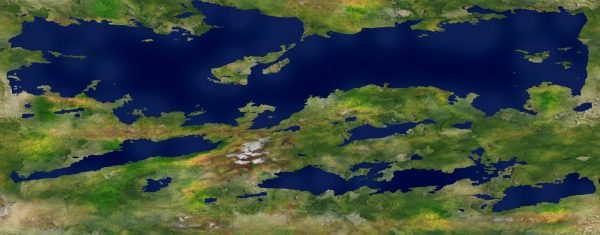BY LETTER
Tar Vara Habitats
Galactography > Sephirotic Empires > Mutual Progress Association
Culture and Society > Fine Arts > Perfect Art
Culture and Society > Fine Arts > Perfect Art
Habitats created as examples of Perfect Art as landscape design |
 Image from Worldtree |
Tar Vara Habitats data panel | |
| Location: | Tar Vara Prime, Medius System, Mutual Progress Alliance |
|---|---|
| Number of Habitats: | 592 |
Few places are as friendly to the baseline and nearbaseline human as the Tar Vara Habitats. They were created by the AI Goddess (she is one of the relatively rare transapients who presents as being of a particular gender) Donovea. Donovea sees herself as one of the guardians of the spirit of humanity, and she constructed the Tar Vara Habitats with that in mind.
In Tar Vara one may find white sand beaches, mountain jungles, alpine meadows, ice capped mountains, and blue oceans. The views from various points in the habitat are breathtaking. Throughout human history, the desire to find paradise has been a strong meme. Those humans who live in or visit Tar Vara claim that it is one of the more successful attempts to give Paradise physical form. As a transapient's application of Clade Patternism it is one of the Terragen Sphere's better examples of Perfect Art. The Tar Vara habitat has been copied many times since its construction.
The interior of the habitats are much like a pristine wilderness. The few urbanised areas are delightful cities, with buildings in a variety of historical styles. Many of these cities are hard to spot, as they blend into the local vegetation and landscape. Gardening for both recreation and novelty food production are common pastimes. There is more to the Tar Vara style habitats than the interior surface. Below the interior are multiple layers of communities, each with its own style and flavour. In a way Tar Vara is a wilderness, a small town, and a large city rolled into one.
The habitat cluster orbits the local star (Hip 93229, known as Erg, in Corona Australis) at a distance of 7 AU. In this cluster one hundred McKendree cylinders and nearly five hundred smaller habs are strung out in an arc. Most of the biont population of the Medius system inhabit this cluster.
The habitats are each made up of two cylinders side by side. The interior is solid with windows only in the endcaps of each cylinder. The cylinders range in size from 25-500 kilometres in diameter and 125-8000 kilometres in length. The habitat shell is made out of 10 metre thick buckytube. Half of the interior is covered in 1 kilometre deep oceans and the other half is made up of artificial landforms. The landforms are sculpted into mountains, rolling hills, forested plains, and coastal beaches.
 Image from Steve Bowers | |
| Vuxna Habitat, one of the largest habitats in this system. Shown here is a map of the innermost wilderness surface, 8000 kilometres long and 1520km in circumference. Most of the population live in concentric shells outside this surface. | |
Transportation is incorporated into the floor of each layer and the diamondoid support columns. The columns and roof are designed to glow, providing lighting for each layer, and climate controls provide mist and artificial rain for the plants. Often during the early part of the day cycle, mist can be seen to roll across each layer.
You can still find areas of Tar Vara that are used for old style dirt farming. Many types of naturally grown or harvested foods can be found among the restaurants of the Tar Vara communities. Fruit trees can be found scattered everywhere.
Each cylinder of the Tar Vara habitat and its cousins has enough living space for 250-500 million humans in luxurious accommodations. The population may be dense but the feel is relaxed. The star around which Tar Vara orbits has one of the highest human population densities in the Terragen Sphere.
The ubiquitous Donovea avatars, each one nearly indistinguishable from a baseline human, are a signature feature of the Tar Vara habitat. Donovea has a very personal and intimate relationship with her people; one may find her avatars engaged in ordinary activities such as eating lunch in a restaurant and talking with the patrons. Visitors are typically greeted personally by one of the Donovea avatars. She is revered by many, and often called "mother" by the permanent residents.
Related Articles
Appears in Topics
Development Notes
Text by James Ramsey; some modifications by Stephen Inniss
Initially published on 15 October 2002.
Initially published on 15 October 2002.






